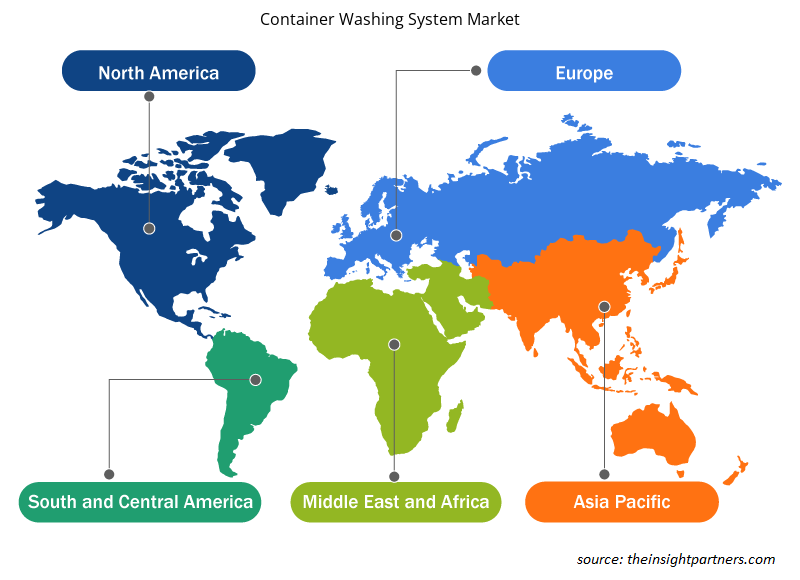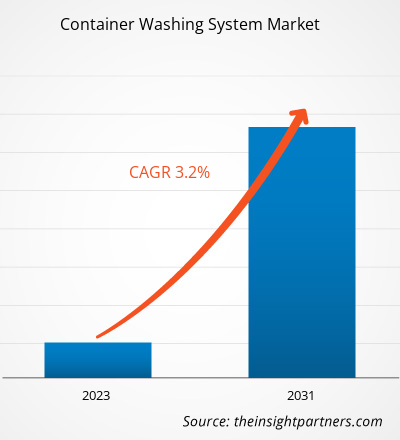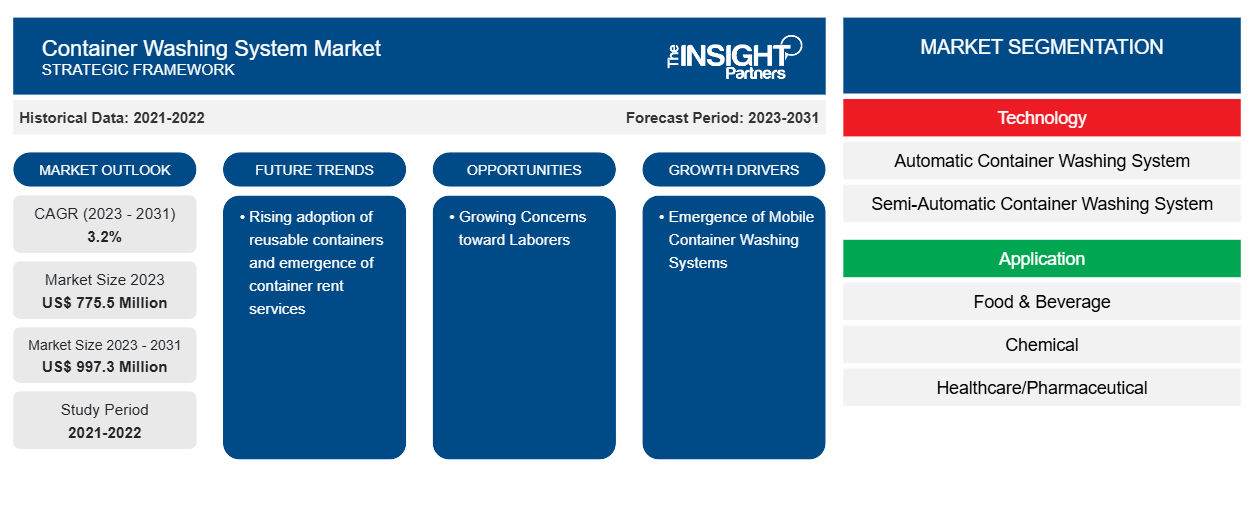Se proyecta que el tamaño del mercado de sistemas de lavado de contenedores alcance los 997,3 millones de dólares estadounidenses en 2031, frente a los 775,5 millones de dólares estadounidenses en 2023. Se espera que el mercado registre una CAGR del 3,2 % entre 2023 y 2031. La creciente adopción de contenedores reutilizables y la aparición de servicios de alquiler de contenedores se encuentran entre los factores clave que impulsan el mercado de sistemas de lavado de contenedores.
Análisis del mercado de sistemas de lavado de contenedores
El mercado mundial de lavado de contenedores está ganando terreno debido a la creciente adopción de contenedores reutilizables en la cadena de suministro para el almacenamiento y el transporte y la aparición de contenedores de alquiler debido a la dinámica altamente volátil de los negocios actuales. Además, la creciente inclinación por la automatización de diversas operaciones en las instalaciones con el fin de aumentar la eficiencia general se encuentra entre otros factores que impulsan el crecimiento de los sistemas de lavado de contenedores. Sin embargo, el alto costo de los sistemas de lavado de contenedores está obstaculizando el crecimiento del mercado de sistemas de lavado de contenedores. Mientras tanto, se prevé que la creciente inclinación por la seguridad en el lugar de trabajo cree amplias oportunidades para los actores del mercado de sistemas de lavado de contenedores.
Descripción general del mercado de sistemas de lavado de contenedores
La industria de alimentos y bebidas en todo el mundo utiliza cajas de diferentes formas y tamaños para todo tipo de propósitos. La limpieza de estas cajas es uno de los procesos más importantes de la industria antes del transporte de productos alimenticios para reducir la contaminación. La población estadounidense se está volviendo más consciente de la salud y se centra en consumir diferentes tipos y fuentes de alimentos procesados . Por lo tanto, el procesamiento general de estos productos alimenticios requiere una seguridad adecuada mediante la limpieza de los contenedores. De manera similar, el sector de la salud en la región está en auge. Los dispositivos médicos se almacenan en contenedores para evitar la contaminación, y estos contenedores deben limpiarse periódicamente.
De manera similar, la industria de fabricación de medicamentos toma las precauciones adecuadas al mezclar la composición de diferentes productos químicos en un recipiente durante la fabricación de medicamentos; por lo tanto, la limpieza de los recipientes es un paso crucial. Por lo tanto, la instalación de sistemas de lavado de recipientes está aumentando en las industrias de alimentos y bebidas y atención médica. Varios fabricantes de sistemas de lavado de recipientes se están centrando en el desarrollo y la expansión de sus negocios en todo el mundo.
Personalice este informe según sus necesidades
Obtendrá personalización en cualquier informe, sin cargo, incluidas partes de este informe o análisis a nivel de país, paquete de datos de Excel, así como también grandes ofertas y descuentos para empresas emergentes y universidades.
-
Obtenga las principales tendencias clave del mercado de este informe.Esta muestra GRATUITA incluirá análisis de datos, desde tendencias del mercado hasta estimaciones y pronósticos.
Impulsores y oportunidades del mercado de sistemas de lavado de contenedores
Aparición de sistemas móviles de lavado de contenedores
La mayoría de los sistemas de lavado de contenedores desarrollados son fijos. Debido a la dinámica cambiante de las operaciones comerciales y para superar el obstáculo del transporte de los contenedores al lugar de lavado, Villiger Entsorgungssysteme AG ofrece sistemas de lavado de contenedores móviles. El sistema de lavado de contenedores se monta en la parte trasera del camión y funciona con diésel. El sistema de lavado de contenedores está equipado con una boquilla de alta presión y cepillos para limpiar contenedores semisubsuelo, sobre el piso y bajo el piso. El sistema también está conectado a canaletas colectoras y tanques para desechos y agua dulce. El sistema de lavado de contenedores móvil elimina la necesidad de instalar el sistema en un lugar específico, lo que permite flexibilidad y reduce el costo de transportar una gran cantidad de contenedores de un lugar a otro para operaciones de limpieza.Villiger Entsorgungssysteme AG offers mobile container washing systems. The container washing system is mounted on the back of the truck and is powered by diesel. The container washing system is equipped with a high-pressure nozzle and brushes for cleaning semi-underfloor, above-floor, and underfloor containers. The system is also attached to collecting troughs and tanks for waste and freshwater. The mobile container washing system eliminates the need for system installation in a specific place, thereby enabling flexibility and reducing the cost of transporting a large number of containers from one place to another for cleaning operations.
Creciente preocupación por la higiene y seguridad de los trabajadores
La seguridad en el lugar de trabajo es uno de los parámetros cruciales para las organizaciones. Las organizaciones están obligadas a proporcionar la infraestructura necesaria en lo que respecta a la salud y la seguridad de los empleados. Los trabajadores que trabajan en instalaciones que manejan sustancias peligrosas, como productos químicos tóxicos, deben estar equipados con el equipo y los implementos de seguridad necesarios para realizar diversas operaciones. Los estándares regulatorios en materia de higiene y saneamiento en los sectores de alimentos y bebidas y atención médica están aumentando. Por lo tanto, se prevé que la creciente necesidad de seguridad en el lugar de trabajo, respaldada por el aumento de los estándares de higiene y saneamiento, cree amplias oportunidades para los actores que operan en el mercado de sistemas de lavado de contenedores.
Análisis de segmentación del informe de mercado del sistema de lavado de contenedores
Los segmentos clave que contribuyeron a la derivación del análisis del mercado del sistema de lavado de contenedores son la tecnología y la aplicación.
- Según la tecnología, el mercado de sistemas de lavado de contenedores se ha dividido en sistemas de lavado de contenedores automáticos y sistemas de lavado de contenedores semiautomáticos. El segmento de sistemas de lavado de contenedores automáticos tuvo una mayor participación de mercado en 2023.
- Según la aplicación, el mercado de sistemas de lavado de contenedores se ha dividido en alimentos y bebidas, productos químicos, atención médica/farmacéutica, petróleo y gas, entre otros. El segmento de alimentos y bebidas tuvo una mayor participación de mercado en 2023.
Análisis de la cuota de mercado de los sistemas de lavado de contenedores por geografía
El alcance geográfico del informe de mercado del sistema de lavado de contenedores se divide principalmente en cinco regiones: América del Norte, Europa, Asia Pacífico, Medio Oriente y África y América del Sur.
La región de Asia Pacífico ha registrado la mayor tasa de crecimiento en el mercado de sistemas de lavado de contenedores durante el período de pronóstico. La región de Asia incluye Australia, China, India, Japón, Corea del Sur y el resto de Asia Pacífico. Asia Pacífico se caracteriza por la rápida industrialización, el aumento de los ingresos disponibles y una gran población joven. Se proyecta que Asia Pacífico creará las mayores oportunidades de crecimiento debido a la creciente adopción de alimentos envasados en la región. Además, la alta tasa de crecimiento del sector farmacéutico y de la salud, junto con el aumento del consumo de combustibles fósiles en APAC, está impulsando posteriormente el crecimiento del mercado. Se pronostica que la industria del petróleo y el gas de la región será testigo de un aumento en las fusiones y adquisiciones, y las decisiones finales de inversión (FID). El crecimiento del sector del petróleo y el gas impulsará las actividades upstream y downstream: la creciente demanda de la industria del petróleo y el gas de sistemas de lavado de contenedores utilizados para almacenar y transportar petróleo. Por lo tanto, el aumento de la inversión en toda la industria del petróleo y el gas aceleraría la adopción de sistemas de lavado de contenedores.
Perspectivas regionales del mercado de sistemas de lavado de contenedores
Los analistas de Insight Partners explicaron en detalle las tendencias y los factores regionales que influyen en el mercado de sistemas de lavado de contenedores durante el período de pronóstico. Esta sección también analiza los segmentos y la geografía del mercado de sistemas de lavado de contenedores en América del Norte, Europa, Asia Pacífico, Oriente Medio y África, y América del Sur y Central.

- Obtenga datos regionales específicos para el mercado de sistemas de lavado de contenedores
Alcance del informe de mercado del sistema de lavado de contenedores
| Atributo del informe | Detalles |
|---|---|
| Tamaño del mercado en 2023 | US$ 775,5 millones |
| Tamaño del mercado en 2031 | US$ 997,3 millones |
| CAGR global (2023 - 2031) | 3,2% |
| Datos históricos | 2021-2022 |
| Período de pronóstico | 2023-2031 |
| Segmentos cubiertos |
Por tecnología
|
| Regiones y países cubiertos |
América del norte
|
| Líderes del mercado y perfiles de empresas clave |
|
Densidad de actores del mercado: comprensión de su impacto en la dinámica empresarial
El mercado de sistemas de lavado de contenedores está creciendo rápidamente, impulsado por la creciente demanda de los usuarios finales debido a factores como la evolución de las preferencias de los consumidores, los avances tecnológicos y una mayor conciencia de los beneficios del producto. A medida que aumenta la demanda, las empresas amplían sus ofertas, innovan para satisfacer las necesidades de los consumidores y aprovechan las tendencias emergentes, lo que impulsa aún más el crecimiento del mercado.
La densidad de actores del mercado se refiere a la distribución de las empresas o firmas que operan dentro de un mercado o industria en particular. Indica cuántos competidores (actores del mercado) están presentes en un espacio de mercado determinado en relación con su tamaño o valor total de mercado.
Las principales empresas que operan en el mercado de sistemas de lavado de contenedores son:
- Grupo de equipos Dyetech, Inc.
- Sistemas de limpieza Feistmantl GmbH
- Glatt GmbH
- HOBART GmbH
- Sistema de limpieza Kärcher Pvt. Limitado. Limitado.
- Numafa Limpieza y automatización BV
Descargo de responsabilidad : Las empresas enumeradas anteriormente no están clasificadas en ningún orden particular.

- Obtenga una descripción general de los principales actores clave del mercado de sistemas de lavado de contenedores
Noticias y desarrollos recientes del mercado de sistemas de lavado de contenedores
El mercado de sistemas de lavado de contenedores se evalúa mediante la recopilación de datos cualitativos y cuantitativos posteriores a la investigación primaria y secundaria, que incluye publicaciones corporativas importantes, datos de asociaciones y bases de datos. A continuación, se incluye una lista de los avances en el mercado de sistemas de lavado de contenedores y las estrategias:
- En octubre de 2023, Newman presentó nuevas ventajas con Archview Tank Wash. Esto ha fortalecido la presencia y la oferta de productos de la empresa en este mercado.
- En noviembre de 2020, los socios de SF Engineering en UNIKON realizaron varias mejoras técnicas en la serie UN de lavadoras industriales para que las máquinas sean aún más higiénicas. Algunas de las mejoras que se han realizado son el chaflán para el drenaje de agua, la extensión del tanque, tornillos en lugar de soldadura, reequipamiento de filtro rotativo, armario de control, zonas separadas, conexión de ventilador y cuchillas de aire y drenaje de agua de condensación.
Informe de mercado sobre sistemas de lavado de contenedores: cobertura y resultados
El informe “Tamaño y pronóstico del mercado del sistema de lavado de contenedores (2021-2031)” proporciona un análisis detallado del mercado que cubre las siguientes áreas:
- Tamaño del mercado y pronóstico a nivel global, regional y nacional para todos los segmentos clave del mercado cubiertos bajo el alcance
- Dinámica del mercado, como impulsores, restricciones y oportunidades clave
- Principales tendencias futuras
- Análisis detallado de las cinco fuerzas de Porter
- Análisis del mercado global y regional que cubre las tendencias clave del mercado, los principales actores, las regulaciones y los desarrollos recientes del mercado.
- Análisis del panorama de la industria y de la competencia que abarca la concentración del mercado, el análisis de mapas de calor, los actores destacados y los desarrollos recientes
- Perfiles de empresas detallados con análisis FODA
- Análisis histórico (2 años), año base, pronóstico (7 años) con CAGR
- Análisis PEST y FODA
- Tamaño del mercado, valor/volumen: global, regional y nacional
- Industria y panorama competitivo
- Conjunto de datos de Excel
Informes recientes
Testimonios
Razón para comprar
- Toma de decisiones informada
- Comprensión de la dinámica del mercado
- Análisis competitivo
- Información sobre clientes
- Pronósticos del mercado
- Mitigación de riesgos
- Planificación estratégica
- Justificación de la inversión
- Identificación de mercados emergentes
- Mejora de las estrategias de marketing
- Impulso de la eficiencia operativa
- Alineación con las tendencias regulatorias























 Obtenga una muestra gratuita para - Mercado de sistemas de lavado de contenedores
Obtenga una muestra gratuita para - Mercado de sistemas de lavado de contenedores